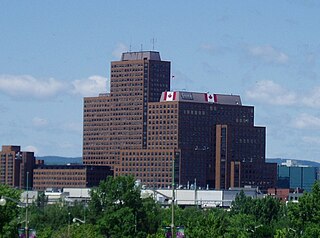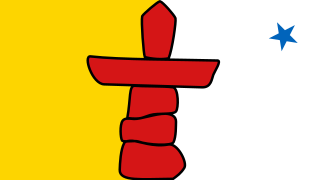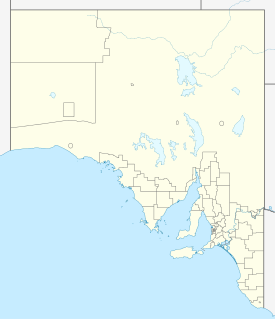
Iqaluit is the capital of the Canadian territory of Nunavut, its largest community, and its only city. It was known as Frobisher Bay from 1942 to 1987, after the large bay on the coast of which the city is situated. In 1987, its traditional Inuktitut name was restored.

The Northwest Territories is a federal territory of Canada. At a land area of approximately 1,144,000 km2 (442,000 sq mi) and a 2016 census population of 41,786, it is the second-largest and the most populous of the three territories in Northern Canada. Its estimated population as of 2020 is 44,904. Yellowknife became the territorial capital in 1967, following recommendations by the Carrothers Commission.

The provinces and territories of Canada are sub-national divisions within the geographical areas of Canada under the jurisdiction of the Canadian Constitution. In the 1867 Canadian Confederation, three provinces of British North America—New Brunswick, Nova Scotia, and the Province of Canada —were united to form a federated colony, becoming a sovereign nation in the next century. Over its history, Canada's international borders have changed several times, and the country has grown from the original four provinces to the current ten provinces and three territories. Together, the provinces and territories make up the world's second-largest country by total area.

Grise Fiord is an Inuit hamlet in the Qikiqtaaluk Region in the territory of Nunavut, Canada. Despite its low population, it is the largest community and only public community on Ellesmere Island, this also makes it the northernmost public community in Canada. It is also one of the coldest inhabited places in the world, with an average yearly temperature of −16.5 °C (2.3 °F).

Arviat is a predominantly Inuit hamlet located within Inuit Nunangat on the western shore of Hudson Bay in the Kivalliq Region of Nunavut, Canada. Arviat is derived from the Inuktitut word arviq meaning "Bowhead whale". Earlier in history, its name was Tikirajualaaq, and Ittaliurvik,.

Cambridge Bay is a hamlet located on Victoria Island in the Kitikmeot Region of Nunavut, Canada. It is the largest settlement on Victoria Island. Cambridge Bay is named for Prince Adolphus, Duke of Cambridge, while the traditional Inuinnaqtun name for the area is Ikaluktutiak or Iqaluktuttiaq meaning "good fishing place".

Crown-Indigenous Relations and Northern Affairs Canada is the department of the Government of Canada responsible for Canada's northern lands and territories, and one of two departments with responsibility for policies relating to Indigenous peoples in Canada.

Resolute or Resolute Bay is an Inuit hamlet on Cornwallis Island in Nunavut, Canada. It is situated at the northern end of Resolute Bay and the Northwest Passage and is part of the Qikiqtaaluk Region.

Hunter A. Tootoo is a Canadian politician who served as the Member of Parliament for Nunavut from 2015 to 2019. Elected as a Liberal to the House of Commons, he was appointed Minister of Fisheries, Oceans and the Canadian Coast Guard by Justin Trudeau on November 4, 2015. Tootoo resigned from that position on May 31, 2016, to take a leave from Parliament to seek treatment for alcohol addiction. He returned to Parliament by the end of July 2016 after the completion of his treatment program, but sat as an independent member for the remainder of the 42nd Parliament and did not run for re-election.

Canada is divided into six time zones, based on proposals by Scottish Canadian railway engineer Sir Sandford Fleming, who pioneered the use of the 24-hour clock, the world's time zone system, and a standard prime meridian. Most of Canada operates on standard time from the first Sunday in November to the second Sunday in March and daylight saving time the rest of the year.
Elections Nunavut is an independent agency that oversees elections and plebiscites in Nunavut, including:

Nunavut is the newest, largest, and most northerly territory of Canada. It was separated officially from the Northwest Territories on April 1, 1999, via the Nunavut Act and the Nunavut Land Claims Agreement Act, though the boundaries had been drawn in 1993. The creation of Nunavut resulted in the first major change to Canada's political map since incorporating the province of Newfoundland in 1949.
The Nunavut Land Claim Agreement was signed on May 25, 1993, in Iqaluit, by representatives of the Tunngavik Federation of Nunavut, the Government of Canada and the Government of the Northwest Territories. This agreement gave the Inuit of the central and eastern Northwest Territories a separate territory called Nunavut. It is the largest Aboriginal land claim settlement in Canadian history. The NLCA consists of 42 chapters, which address a broad range of political and environmental rights and concerns including wildlife management and harvesting rights, land, water and environmental management regimes, parks and conservation areas, heritage resources, public sector employment and contracting, and a range of other issues. The agreement indicates two areas that are the focus of the agreement: the first area consists of the Arctic islands and the mainland eastern Arctic, and their adjacent marine areas; the second area includes the Belcher Islands, its associated islands and adjacent marine areas.
Nellie Taptaqut Kusugak of Rankin Inlet, Nunavut is the fifth Commissioner of Nunavut.
Edna Agnes Ekhivalak Elias is a Canadian politician from Kugluktuk, Nunavut. On 12 May 2010 she was appointed as the 4th Commissioner of Nunavut by Prime Minister Stephen Harper. Her term ended on 11 May 2015.

Lucky Bay is a locality in the District Council of Franklin Harbour, on the Spencer Gulf coast of Eyre Peninsula in South Australia. It is a terminus for SeaSA's Spencer Gulf passenger ferry and a transshipping port for grain export operated by T-Ports. Lucky Bay is located immediately north-east of the Franklin Harbour wetlands. Its adjacent waters lie within the outer boundary of the Franklin Harbor Marine Park. A ferry service crossing Spencer Gulf from Lucky Bay to Wallaroo commenced in 2006, and the dirt road connecting Lucky Bay with the Lincoln Highway was sealed in 2008.

The COVID-19 pandemic in Canada is part of the ongoing worldwide pandemic of coronavirus disease 2019 caused by severe acute respiratory syndrome coronavirus 2. The virus was confirmed to have reached Canada on January 27, 2020, after an individual who had returned to Toronto from Wuhan, Hubei, China, tested positive. As of June 12, 2020, there have been over 97,900 confirmed cases, 58,523 recoveries and 8,049 deaths in the country. The Government of Canada has released modelling anticipating 11,000–22,000 deaths over the course of the pandemic, assuming "stronger epidemic control".
As of May 29, 2020, Nunavut is the only territory or province in Canada with no confirmed cases of COVID-19, a novel infectious disease caused by severe acute respiratory syndrome coronavirus 2 (SARS-CoV-2). As part of the global pandemic and its impact on Canada, Nunavut has implemented restrictions on commerce, public gatherings, and travel into the territory by non-residents.












